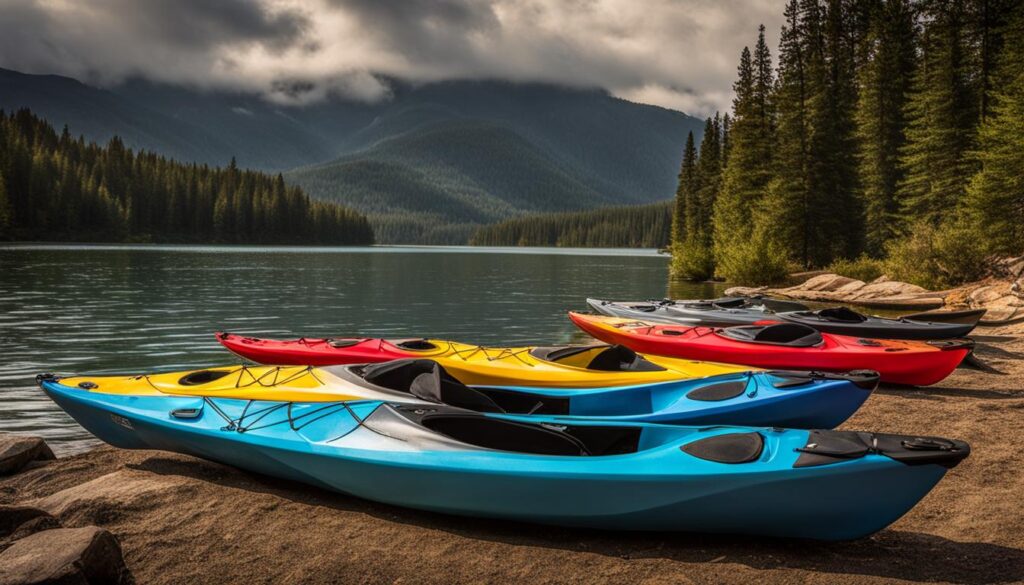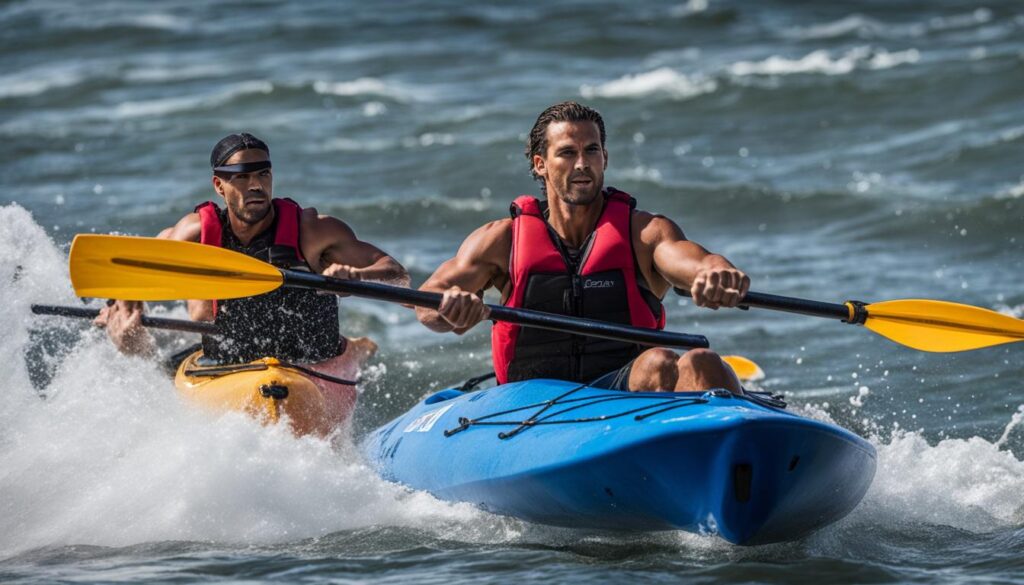Kayaking is a thrilling sport that combines adventure, tranquility, and physical exercise. To make the most of your kayaking experience, it’s crucial to master efficient paddle stroke techniques. In this comprehensive guide, we will explore the basics of kayaking, including different types of kayaks, essential equipment knowledge, and fundamental paddling techniques. We will also delve into the importance of physical conditioning and optimal kayak posture to enhance your paddle stroke efficiency.
Key Takeaways:
- Improving your kayak stroke technique is essential for enhancing your kayaking skills.
- Understanding the basics of kayaking, such as different kayak types and equipment, is crucial before mastering advanced paddle stroke techniques.
- Physical conditioning, including cardiovascular fitness, upper body strength, and core strength, is vital for improved kayaking performance.
- Optimal kayak posture, including proper sitting position, foot position, back alignment, and arm positioning, plays a significant role in efficient paddling.
- By practicing and refining your paddle stroke techniques, you can elevate your kayaking experience and control on the water.
Understanding the Basics of Kayaking
Before you can master advanced paddle stroke techniques, it’s essential to have a solid foundation in the basics of kayaking. Let’s dive into the fundamental aspects that every kayaker should understand.
Types of Kayaks
Kayaks come in various types, each designed for specific purposes. Understanding the different types will help you choose the most suitable kayak for your needs. Here are some common types:
- Recreational kayaks: These kayaks are great for beginners and casual paddlers. They offer stability and ease of use.
- Touring kayaks: Ideal for longer journeys, touring kayaks have more storage space and are built for stability in open waters.
- Whitewater kayaks: Specifically designed for navigating fast-moving rivers and rapids, these kayaks are maneuverable and equipped with specialized features.
- Sea kayaks: Built for extended trips in the ocean or large lakes, sea kayaks are efficient, stable, and have ample storage capacity.
Equipment Knowledge
Being familiar with the equipment used in kayaking is crucial for your safety and enjoyment. Here are some essential items:
- Paddle: Choose a paddle that suits your height and paddling style. A proper paddle ensures efficient strokes.
- Life Jacket (PFD): Always wear a well-fitting and Coast Guard-approved personal flotation device for safety.
- Spray Skirt: Required for whitewater and sea kayaking, a spray skirt keeps water out of the cockpit.
- Helmets and Protective Gear: Necessary for whitewater kayaking to protect against potential impacts.
Water Awareness and Basic Paddling Techniques
Before hitting the water, it’s important to be aware of your surroundings and potential hazards. Take note of currents, tides, and weather conditions. When it comes to basic paddling techniques, here are a few to focus on:
- Forward Stroke: The most common stroke, used for propelling the kayak forward.
- Backward Stroke: Used for reversing or stopping the kayak.
- Sweep Stroke: A wide stroke used for turning the kayak.
Body Positioning
Proper body positioning is key to effective paddling. Pay attention to the following:
- Sitting Position: Sit upright with your back straight and avoid slouching.
- Foot Position: Place your feet against the footpegs for stability and control.
- Arm Position: Hold the paddle with a relaxed grip and keep your arms at a comfortable angle.
- Torso Rotation: Engage your core and rotate your torso with each stroke to generate power.
By mastering these basic aspects of kayaking, you’ll build a strong foundation for improving your paddle stroke techniques and taking your kayaking skills to the next level.

Table: Comparison of Kayak Types
| Kayak Type | Best For | Features |
|---|---|---|
| Recreational Kayaks | Beginners and casual paddlers | Stability, ease of use |
| Touring Kayaks | Longer journeys in open waters | Storage space, stability |
| Whitewater Kayaks | Fast-moving rivers and rapids | Maneuverability, specialized features |
| Sea Kayaks | Extended trips in the ocean or large lakes | Efficiency, stability, storage capacity |
Importance of Physical Conditioning for Kayaking
Physical conditioning is of utmost importance when it comes to excelling in kayaking. By focusing on cardiovascular fitness, upper body strength, core strength, and flexibility, you can enhance your performance on the water and enjoy a more rewarding kayaking experience.
Cardiovascular fitness plays a crucial role in sustaining endurance and stamina during long kayaking trips. Engaging in regular cardio exercises such as running, cycling, or swimming can improve your cardiovascular health and ensure you have the energy and stamina to paddle for extended periods.
Building upper body strength is essential for generating powerful paddle strokes. Strong arms, shoulders, and back muscles allow for more efficient and forceful strokes, enabling you to maneuver through the water with greater ease. Incorporating exercises like push-ups, pull-ups, and weightlifting into your fitness routine can help you develop the strength necessary for kayaking.
Core strength is equally important as it provides stability and balance while paddling. A strong core enables you to maintain proper posture, transfer power from your upper body to the paddle, and navigate through various water conditions. Including exercises like planks, sit-ups, and Russian twists in your workout regimen can help strengthen your core muscles.
Finally, don’t overlook the significance of flexibility. Stretching exercises or practicing yoga can improve your range of motion, allowing for better paddle reach and reducing the risk of injuries. Flexibility also contributes to fluid movements and smoother transitions between strokes.
Table: Key Physical Conditioning Factors for Kayaking
| Physical Conditioning Aspect | Key Benefits | Exercise Examples |
|---|---|---|
| Cardiovascular Fitness | Boosts endurance and stamina | Running, cycling, swimming |
| Upper Body Strength | Enables powerful paddle strokes | Push-ups, pull-ups, weightlifting |
| Core Strength | Enhances stability and balance | Planks, sit-ups, Russian twists |
| Flexibility | Improves range of motion and reduces injury risk | Stretching exercises, yoga |
By prioritizing physical conditioning and incorporating these exercises into your fitness routine, you can optimize your performance as a kayaker. Remember, a well-conditioned body is better equipped to handle the physical demands of kayaking and allows you to fully enjoy this exhilarating outdoor activity.

Optimal Kayaking Posture
When it comes to kayaking, maintaining the correct posture is essential for efficient paddling and injury prevention. By adopting the optimal kayaking posture, you can optimize your paddle stroke efficiency and enjoy a smoother kayaking experience. Here are some key elements to consider:
Sitting Position
Start by sitting with proper alignment in the kayak seat. Sit upright, with your back straight and your hips and buttocks positioned towards the back of the seat. Avoid slouching or leaning too far forward, as this can cause strain and discomfort during prolonged paddling sessions.
Foot Position
Ensuring a stable foot position is crucial for maintaining balance and control while paddling. Place your feet against the footpegs, keeping them comfortably pressed against the pegs. This will provide stability and allow for efficient transfer of power from your upper body to the paddle.
Back Position
Maintaining a straight back position is important for proper spinal alignment and optimal power transfer. Engage your core muscles to support your back and avoid slumping or rounding your shoulders. By keeping your back straight, you will be able to generate more power and paddle with greater efficiency.
Arm Position
Hold the paddle with a relaxed grip, allowing your wrists to remain flexible. Your arms should be slightly bent, with the elbows positioned at a comfortable angle. Avoid excessive tension in your arms and shoulders, as this can lead to fatigue and decreased performance.
Torso Rotation
Utilizing torso rotation during paddling is a key technique for maximizing the power and effectiveness of your paddle strokes. Coordinate the movement of your upper body with each paddle stroke, engaging your core muscles and rotating your torso. This rotation will allow you to engage larger muscle groups and generate more propulsion with each stroke.
By practicing and maintaining optimal kayaking posture, you can enhance your paddle stroke efficiency, minimize the risk of injury, and enjoy a more comfortable and enjoyable kayaking experience.
Conclusion
Congratulations on completing this comprehensive guide to mastering efficient paddle stroke techniques for kayakers! By understanding and applying the basics of kayaking, focusing on physical conditioning, maintaining optimal kayak posture, and practicing proper paddle stroke techniques, you have taken important steps towards improving your paddling efficiency, power, and control.
Remember, whether you’re a beginner or an experienced kayaker, investing time and effort into mastering paddle stroke techniques will greatly enhance your overall kayaking experience. So, get out on the water, apply these techniques, and enjoy the thrill of mastering your paddle stroke!
Thanks for reading and happy paddling!
FAQ
What are some basic paddling techniques in kayaking?
Basic paddling techniques in kayaking include the forward stroke, backward stroke, and sweep stroke.
How can I improve my physical conditioning for kayaking?
You can improve your physical conditioning for kayaking by focusing on cardiovascular fitness through exercises like running, cycling, and swimming. Strengthening your upper body muscles and developing a strong core are also important.
What is the correct posture for kayaking?
The correct posture for kayaking includes sitting with proper alignment in the kayak seat, keeping your feet against the footpegs, maintaining a straight back position, and utilizing torso rotation during paddling.
How can I enhance my paddle stroke efficiency in kayaking?
You can enhance your paddle stroke efficiency in kayaking by understanding the basics of kayaking, focusing on physical conditioning, maintaining optimal kayak posture, and practicing proper paddle stroke techniques.
Can mastering paddle stroke techniques benefit both beginners and experienced kayakers?
Yes, investing time and effort into mastering paddle stroke techniques can greatly benefit both beginners and experienced kayakers by improving paddling efficiency, power, and control.





